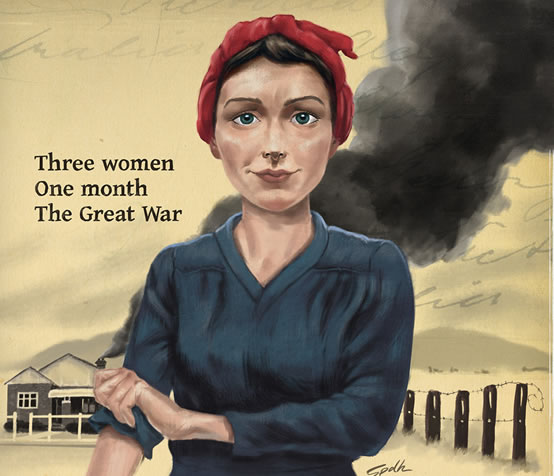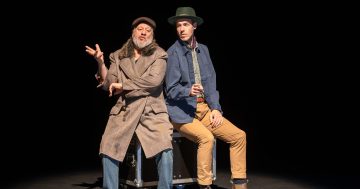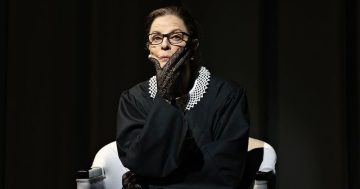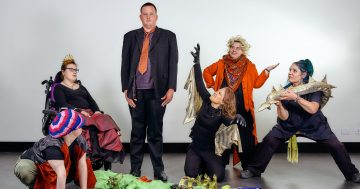
For a while, he seemed to be getting better. He went through a lot in the war, he needed time to heal… She knew it would be hard. But now there are too many bruises – so many that she can’t hide them or laugh them off as clumsy accidents. Her mother-in-law is brutally cold: if her husband is beating her then, well, it’s just because she’s done something to deserve it. Her best friend, a kindly school teacher, urges her to protect herself but cannot always be there for her because of her own struggle with a constant, agonising fear of spiders.
That was the Home Front: a bleak drama about domestic violence, the futility of struggling against a world gone wrong, and (sometimes) the ever-present menace of unholy arachnid hordes.
However if this particular show sounds like something you’d like to see, you’re out of luck. The Home Front is improvised fresh every night from audience suggestions. The play is always about the experience of Australian women during World War 1, but beyond that anything’s possible. The performance I saw focused on a woman living with her abusive husband (a returned but cruelly changed serviceman) but the show you will see is guaranteed to be something completely different.
At the start of the performance director Heidi Silberman (in drag as an army officer) takes the stage, introduces the three actors (Catherine Crowley, Ruth Pieloor and Lynn Petersen) who will be performing the play, and then invites the audience to give them identities – jobs, personalities, fears. With roles assigned these three women then set out to build a story, line by improvised line, drawing on their extensive knowledge of the lives of women during this period in an attempt to create something that is both new and truthful.
Silberman isn’t content to sit on the side-lines: she issues orders, corrects anachronisms and in some cases even takes the stage to directly meddle with the lives of her actors. I had mixed feelings about Silberman’s involvement with the action of the play. On the one hand, she does keep things going when the action starts to sag (an inevitability in an improvised play). There were also charming moments where the performers gleefully competed to subvert Silberman’s demands in clever ways. However the overall effect was one of powerlessness: the women are buffeted by forces they cannot control. Silberman even calls on the lighting designer (a slightly mischievous P.J. Williams) by name, asking him for particular states. It felt as though Hera was asking Apollo to visit calamity on humans who are as powerless as those in any play of Ancient Greece. These stagey elements emphasise the overall theatricality and artificiality of the production. This runs counter to one of improvised theatre’s greatest strengths: the freshness and authenticity of material that is developed on the spot. While this approach had its charms what I really wanted to see was for the story to be left to run in whatever direction the performers naturally took it.
Non-actors sometimes underestimate the difficulty of pure improv: it requires just as much dedication and rehearsal as performance from a script – if not more. Fortunately the three actors rise to the challenge. Catherine Crowley is extremely engaging to watch, restless in the variety and originality of actions she performs. Ruth Pieloor is a more gentle presence on stage but showcases extensive knowledge of the period and more than the others builds the context in which the play takes place. Lynn Petersen on the other hand is determined to find the conflict in every situation and gives the play a lot of its energy and drive. I was very impressed with how Petersen in particular gave her character its own arc, starting off bitter and uncompromising but slowly bending as unwelcome truths crush her prejudices. True, the dialogue does meander sometimes (another inevitability in improv) but the performers rolled on regardless and provided some genuinely moving and dramatic moments.
The improvised nature of the performance both energises and limits the actors. Because the characters are defined by the traits given by the audience they have a single-minded vivid energy. At its best this means that the characters have focus. At its worst, the characters get saddled with tics – in this case, one performer was cursed with a fear of spiders that intruded on the play’s most dramatic moments. However the actors have to run with what they’re given, and Silberman deserves credit for being willing to take risks on the offers she accepts from the audience (although I was surprised to see fear of spiders chosen over a much richer suggestion – a fear of loneliness).
Unfortunately despite the quality of the performances the show is hampered by its domestic staging. The action of the play takes place in a home and the women are given a variety of household tasks to play with: cleaning a fireplace, folding sheets, even dusting cobwebs. The great potential of the World War 1 setting is that the absence of men gives the women the opportunity to break out of their roles as wives and mothers and find new freedom. Instead the performance I saw was entirely about women being wives and mothers. I was shown women folding sheets when I really wanted to see a woman chopping down a tree.
Tellingly, at the start Silberman asks the audience to give each woman a relationship with a man somehow involved in the war. This is a play of women reacting, both to each other in the improv that shapes the show and to the larger world defined and controlled by men. Even Silberman as director has to become a man to give orders to the women. This was an aspect of the show that troubled me, especially because of the way the performance I saw treated domestic violence. For the most part the women just passively put up with it. At the very end the boldest action taken was for the battered wife to go off to the country with her abusive and possibly insane husband. The change will do him good – her well-being is somehow secondary. In this performance at least World War 1 did not provide women with new opportunities, it only pushed them deeper into old identities.
Unfortunately, the cost of improv is that not every show will be the same, and some fall will short. I can only review the performance I actually saw. While I was very impressed by the actors I wanted to see them take the potential of the setting further and I felt the that the decision to set it in a home limited the activities the women could perform. As improv, this is an extraordinary accomplishment. As theatre, it is a more mixed experience. It can be appreciated however for the skill and sheer hard work of the performers who take on an impossible task and do it well. And if you go on just the right night, you might get lucky and see something extraordinary.
When: 18-28 June
Time: 7:30pm
Where: The Street Theatre
Price: $35 standard, $25 concession
Tickets: http://www.thestreet.org.au/?page=homefront





















